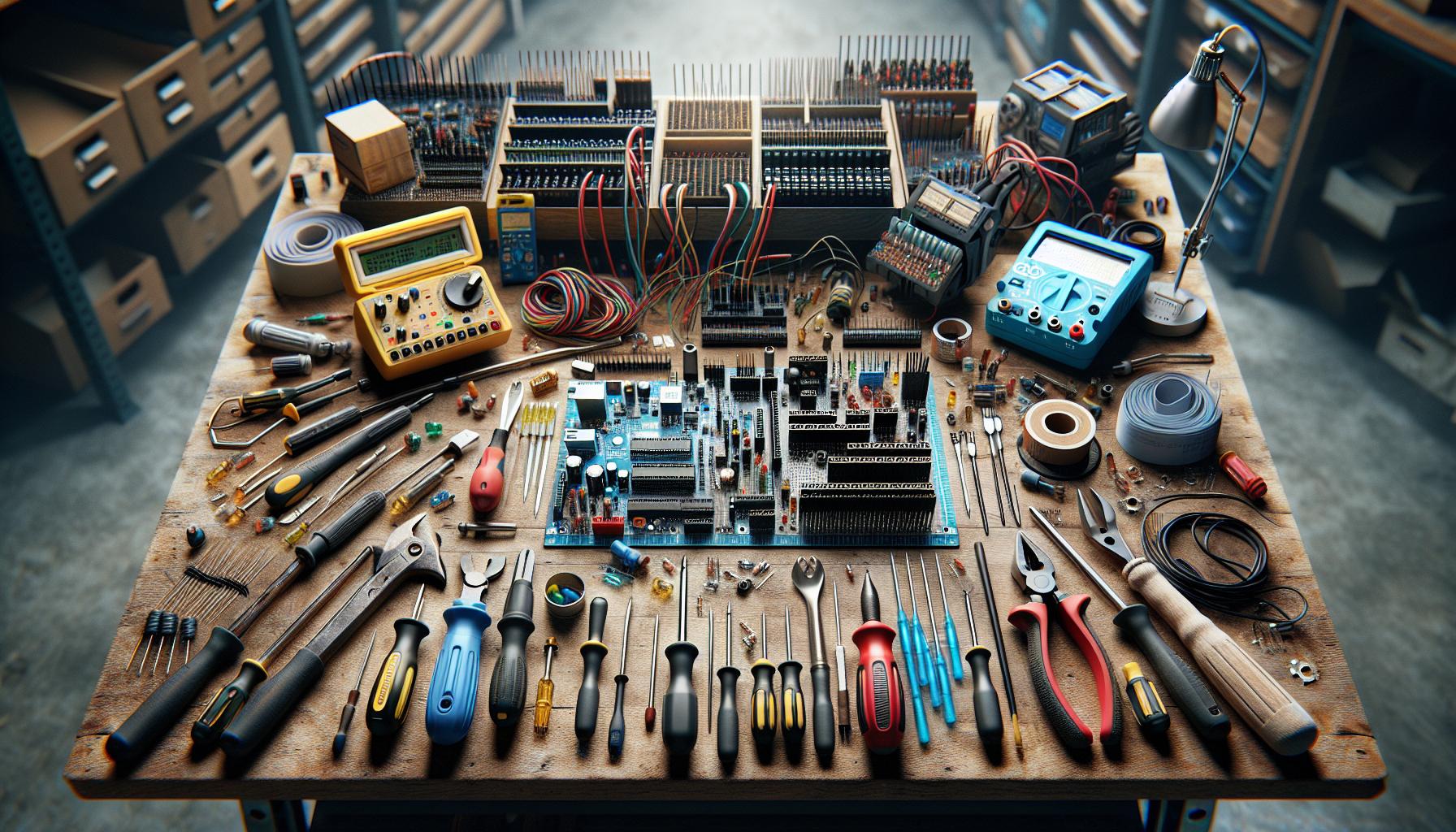If you’re like me and love the thrill of creating something from scratch, DIY tech projects can be incredibly rewarding. They not only spark creativity but also give you the chance to learn new skills and understand technology on a deeper level. Whether you’re a seasoned maker or just starting out, there’s a project out there that’s perfect for you.
Key Takeaways
- Diverse DIY Projects: DIY tech projects range from simple to complex, allowing individuals of all skill levels to engage and learn.
- Skill Enhancement: Participating in these projects develops technical skills like programming and circuit design, as well as critical thinking and problem-solving abilities.
- Cost Savings: Creating devices through DIY projects is often more cost-effective than purchasing commercial products, especially when repurposing old materials.
- Popular Project Types: Common DIY tech projects include home automation, robotics, and drones, each providing unique opportunities for creativity and technical development.
- Essential Tools: A well-equipped workspace with basic tools, including screwdrivers, pliers, soldering irons, and microcontrollers, is vital for successful project execution.
- Planning and Safety: Thorough planning and safety precautions are crucial for the success and enjoyment of DIY tech projects, ensuring a smooth and safe creative process.
DIY Tech Projects
DIY tech projects encompass a wide range of activities that allow individuals to create, innovate, and solve problems using technology. These projects can range from simple electronics, like building a basic circuit, to more complex endeavors such as developing a mobile app or constructing a smart home device.
Individuals can expect to learn valuable skills through these projects. Programming languages, circuit design, and software development offer practical experience that enhances both understanding and confidence.
Projects vary significantly based on skill level and interest. Beginners may start with Arduino kits or Raspberry Pi projects, while those with more experience can tackle robotics, home automation systems, or web applications.
The online community provides abundant resources, including tutorials, videos, and forums. Platforms like Instructables and GitHub foster collaboration and knowledge-sharing, making it easier to find support and inspiration.
By choosing the right project, individuals can explore their interests, develop new technical skills, and enjoy the process of making.
Benefits of DIY Tech Projects

Engaging in DIY tech projects offers numerous advantages that lead to personal growth and development. I explore these benefits in detail below.
Enhancing Skills
Engaging in DIY tech projects enhances various skills crucial for personal and professional growth. I develop technical skills such as programming and circuit design by working on diverse projects. I also improve problem-solving abilities and critical thinking through troubleshooting issues during the project. Additionally, teamwork skills strengthen when collaborating with others, increasing my capacity to communicate effectively.
Cost-Effectiveness
DIY tech projects often provide a cost-effective alternative to purchasing ready-made gadgets. I save money by building devices like smart home systems or custom gadgets, which typically come at a premium in retail settings. Many project materials are affordable and accessible, allowing me to create unique solutions without large expenditures. By repurposing old electronics and using open-source software, I maximize value while minimizing costs.
Popular Types of DIY Tech Projects

DIY tech projects cover a variety of themes, each appealing to different interests and skill levels. Below are some popular categories that highlight the exciting possibilities in the world of DIY.
Home Automation Projects
Home automation projects enable me to enhance convenience and efficiency in daily life. These projects can range from simple tasks like setting up smart lights to complex automation systems controlling integrated devices. Popular options include:
- Smart Lighting: I can easily install programmable LED bulbs to create schedules or control lighting remotely via smartphone apps.
- Smart Thermostats: Implementing an energy-efficient thermostat helps me manage heating and cooling based on my preferences or occupancy, saving energy and reducing utility bills.
- Security Systems: I can build surveillance systems using cameras and sensors to enhance home security. Integrating alerts and remote access improves safety and monitoring capabilities.
Robotics and Drones
Robotics and drone projects challenge me to dive into electronics, coding, and design. They produce tangible results with practical applications. Notable project ideas include:
- Robotic Arms: I can create a robotic arm that mimics the movement of real arms, controlled by a microcontroller and programmed for various tasks.
- Autonomous Drones: Building a drone combines programming and assembly, allowing me to experiment with flight controls and navigation systems using GPS.
- Robot Kits: Engaging with pre-packaged robot kits lets me learn mechanics and programming while assembling a functional robot capable of performing tasks or navigating obstacles.
Each of these project types offers opportunities for creativity, technical skill development, and the satisfaction of creating something functional and innovative.
Essential Tools and Materials

Engaging in DIY tech projects requires key tools and materials that make the process smoother and more efficient. Knowing what to have on hand helps streamline any project, regardless of complexity.
Basic Tools You Need
- Screwdrivers: A set of flathead and Phillips screwdrivers is essential for assembling and disassembling components.
- Pliers: Needle-nose pliers assist in gripping small components, while cutting pliers help with wire trimming.
- Wire Strippers: These tools remove insulation from wires, crucial for creating electrical connections.
- Arduino Starter Kit: This kit provides microcontrollers and components for numerous projects and experimentation.
- Soldering Iron: A soldering iron is necessary for making permanent connections on circuit boards.
- Multimeter: This instrument measures voltage, current, and resistance, ensuring proper function in electronic circuits.
- Hot Glue Gun: A hot glue gun quickly bonds materials, offering flexibility in building structures or securing components.
- Cutting Mat: Protect work surfaces and ensure precision when cutting materials.
- Breadboards: Use breadboards for prototyping circuits without soldering, allowing easy adjustments and experimentation.
- Wire: Keep various gauge wires, such as 22 AWG for connections and 30 AWG for fine work, ready for use in projects.
- Resistors: Standard and variable resistors are key for controlling current in circuits.
- LEDs: Light-emitting diodes add visual feedback and cues in projects.
- Microcontrollers: Components like Arduino or Raspberry Pi help create interactive and programmable projects.
- Sensors: Various sensors, including temperature, motion, and light sensors, expand project capabilities by allowing interaction with the environment.
- Jumper Wires: Flexible jumper wires facilitate connections between components on breadboards for instant prototyping.
- Power Sources: Ensure multiple power sources, including batteries and USB power supplies, support various project requirements.
Tips for Successful DIY Tech Projects
Successful DIY tech projects rely on careful planning and execution. Adhering to specific strategies enhances the overall experience.
Planning and Research
Planning and research form the foundation of any successful DIY tech project. Identify project goals and outline the necessary steps. Gather resources such as tutorials, guides, and community forums to build knowledge. Create a list of required materials and tools before starting the project. Estimate time commitments to stay organized and track progress effectively. Engaging in preliminary experiments can uncover potential challenges, enabling better preparation for execution.
Safety Precautions
Safety precautions are essential in DIY tech projects to prevent accidents. Use personal protective equipment like goggles and gloves. Ensure a well-ventilated workspace when working with electronics and soldering tools. Familiarize yourself with proper handling techniques for tools and materials. Store hazardous substances safely and follow manufacturer instructions for electronic components. Maintain a clutter-free workspace to minimize risks and distractions. By prioritizing safety, I can enjoy the creative process while minimizing potential hazards.
Engaging in DIY tech projects has truly transformed my understanding of technology and sparked my creativity. There’s something incredibly rewarding about taking on a project that challenges me and pushes my skills to new heights. Whether I’m building a simple circuit or diving into robotics, each experience adds to my knowledge and confidence.
The online community offers endless support and inspiration, making it easier to tackle projects regardless of skill level. Plus, I love the cost-effective nature of creating my own gadgets. With the right tools and a bit of planning, I can turn my ideas into reality. So if you’re looking to explore, learn, and create, jumping into DIY tech projects might just be the perfect adventure for you.

